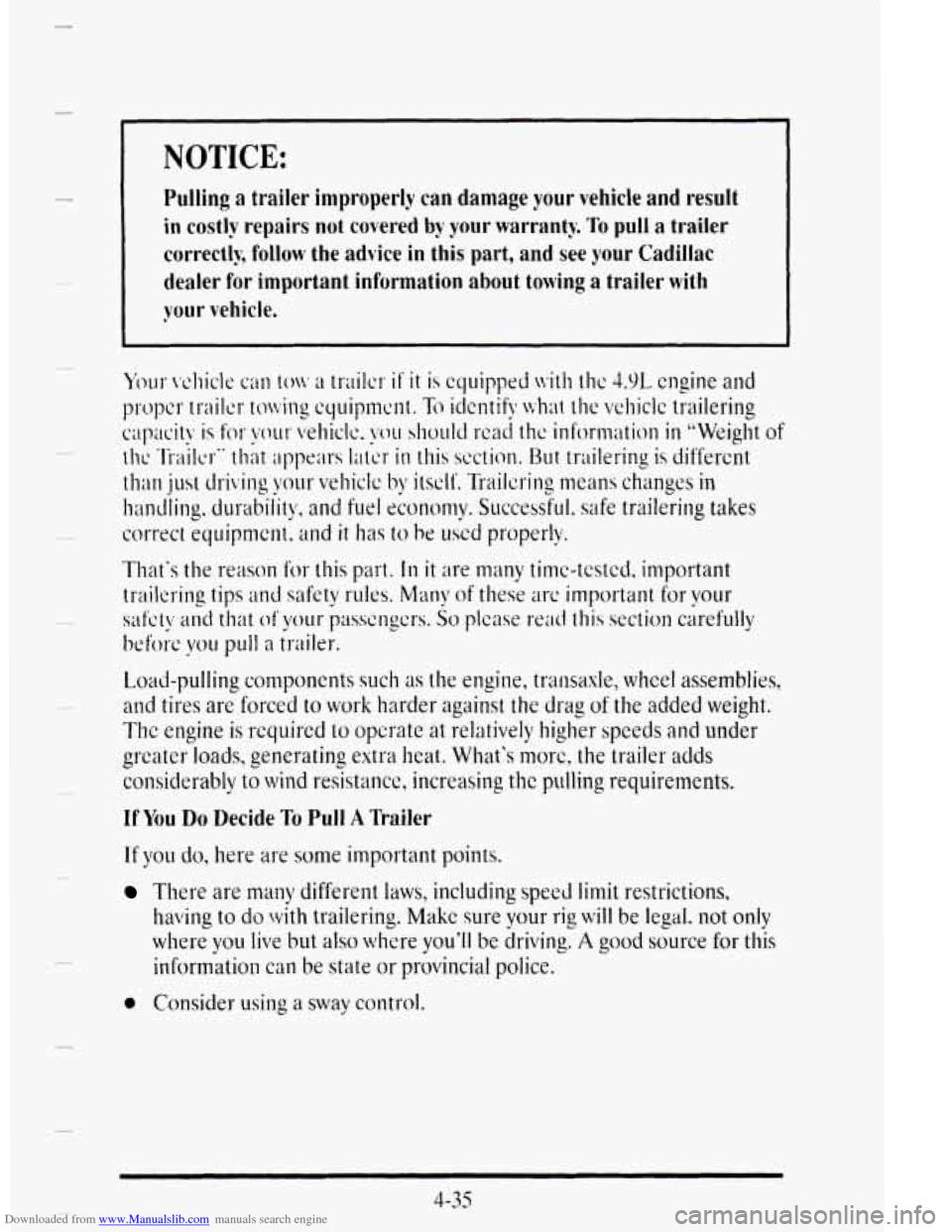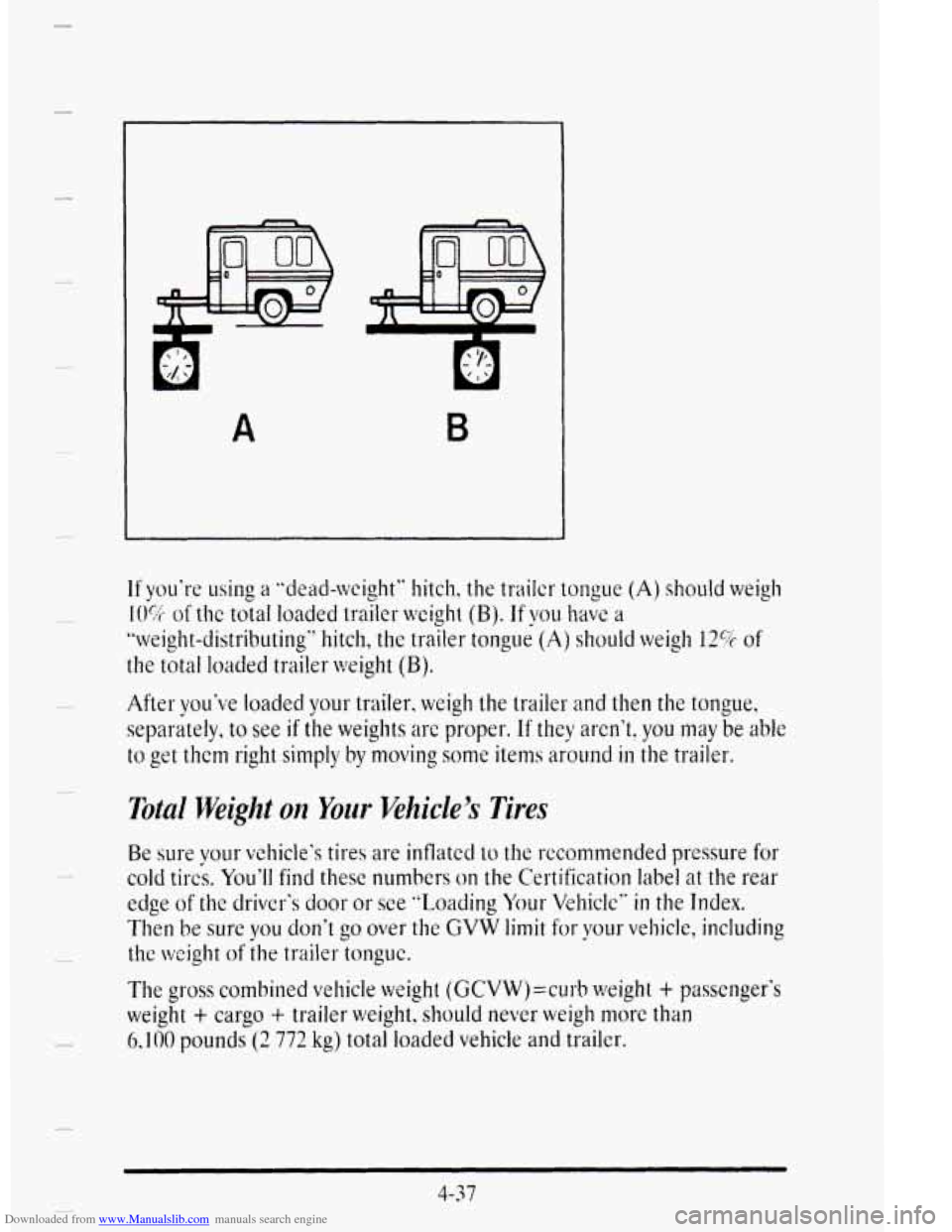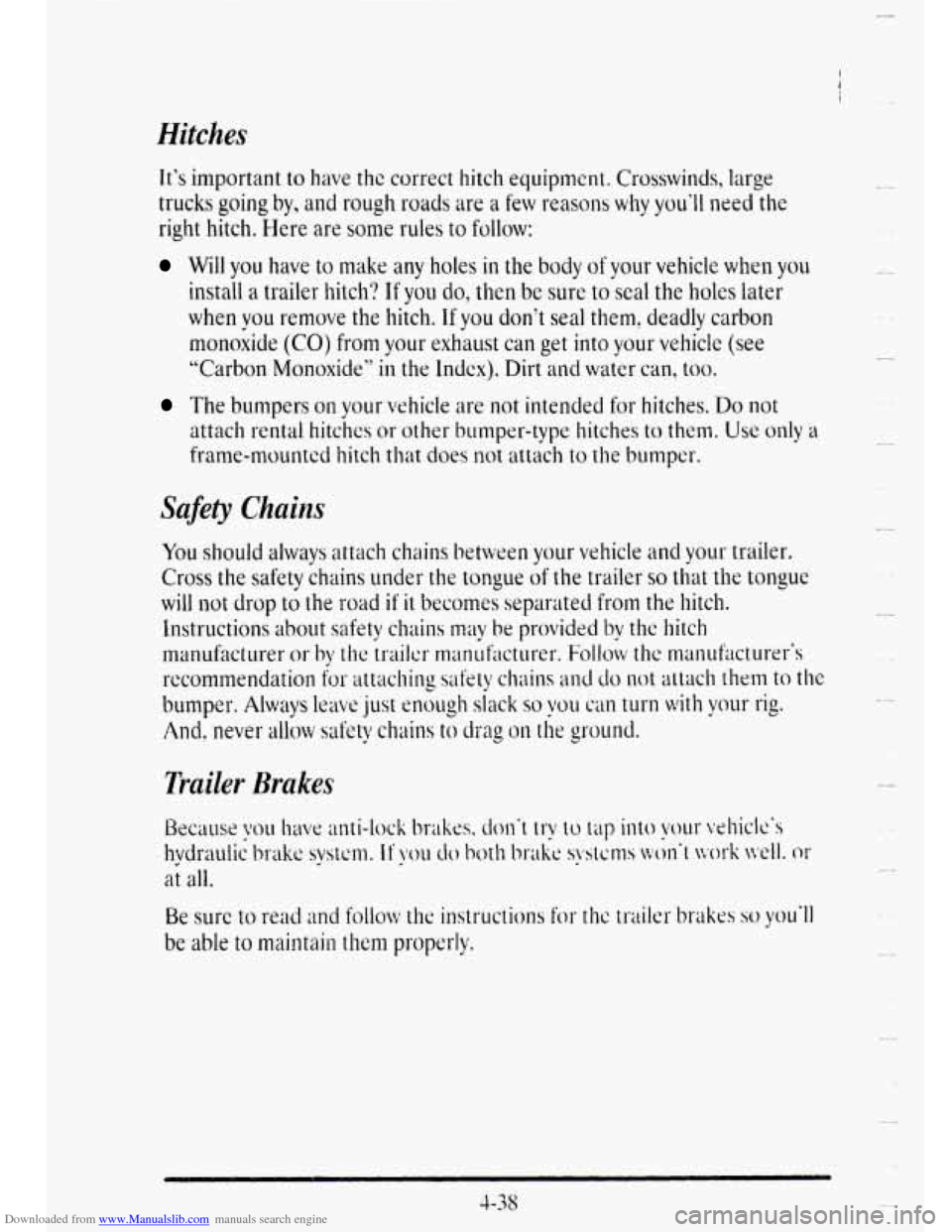Page 93 of 403
Downloaded from www.Manualslib.com manuals search engine 1
NEW VEHICLE “BREAK-IN”
NOTICE:
Your modern Cadillac doesn’t need an elaborate “break-in.” But.
it will perform better in the long run if you follow these.
guidelines:
e Don’t drive at any one speed -- fast or slow -- for the first
500 miles (‘804 km). Don’t make full-throttle starts.
Avoid making hard stops for the first. 200 miles (322 km) or
so. During this time your new brake linings aren’t get broken
in. Hard stops with new linings can mean premature wear
and earlier replacement. Follow this “breaking-in’” guideline
ekeq time you. get: new brake linings.
0 Don‘t: i.0~’ ;Y. traiier during “break-inl” Set: “Towing a Trailer”
in tht: hiex for more intormation.
r.
u
J
Page 103 of 403
Downloaded from www.Manualslib.com manuals search engine NOTICE:
Driving with the parking brake on can cause your rear brakes to
overheat.
You may have to replace them and you could also
damage other parts of your vehicle.
Ifyou are towiqg a trniler nrzci ore parking or1 a hill, see "Towing a Trailer"
in the Index. This section shows what to do first to keep the trailer from
moving.
SHIFTING INTO PARK (P)
-4
-
4
c
u
Page 228 of 403

Downloaded from www.Manualslib.com manuals search engine NOTICE:
Pulling a trailer improperly can damage your vehicle and result
in costly repairs not covered
by your warranty. To pull a trailer
correctly, follow the advice
in this part, and see your Cadillac
dealer for important information about towing a trailer with
your vehicle.
Load-pulling conlponents such as the engine, transaxle, wheel assemblies,
and tires are forced
to work harder against the drag of the added weight.
Thc engine
is required to opcrate at relatively higher speeds and under
greater loads, generating extra heat. What's morc, the trailer adds
considerably
to wind resistance, increasing thc pulling requirements.
If You Do Decide To Pull A Trailer
If you do, here are surne important points.
There are ~nar~y different laws, including speed limit restrictions,
having to do with trailering. Makc sure your rig will be legal. not only
where \;ou live hut also where you'll be driving. A good source for this
infurmition
can IX state or provincial police.
4-35
Page 229 of 403

Downloaded from www.Manualslib.com manuals search engine You can ask a hitch dealer about sway controls.
Don’t tow a trailer at all during the first 1,000 miles ( 1 600 krn) your new
vehicle
is driven. Your engine, axle or other parts could be damaged.
0 Then, during the first 500 miles (800 km) that you tow a trailcr, don’t
drive over
50 mph (80 km/h) and don’t make starts at full throttle. This
helps
your engine and other parts of your vehicle wear in at the
heavier loads.
Obey speed limit restrictions when towing a trailer. Don’t drive faster
than the maximum posted speed
for trailers (or no more than 55 mph
(90 kndh)) to save wear on your vehicle’s parts.
Three important considerations
have to do with weight:
Weight of the Trailer
How heavy can a trailer safely bc?
It should never weigh more than 1.000 pounds (450 kg) total, including
the load.
But even that can be too hcavy.
c
It depends 011 how you plan to use your rig. For example, speed, altitude,
road grades, outsidc tcmperature and how mrrch your vehicle is used to
pull a trailer are all important. And, it can also depend on any spccial
equipment that you have on your vehicle.
In Canada, write to General Motors of Canada Limited, Cilstomer
Assistance Center,
1908 Colonel Sam Drive. Ochawa, Ontario LlH SP7.
Weight of the frailer Tongue
The tongue load (A) of any trailer is an important weight to measure
because it affects the total capacity weight of your vehiclc. The capacity
weight
includes the curb weight of the vehicle, any cargo you may carry in
it, and the people who will be riding it1 the vehicle. And if you will tow a
trailer: you must subtract the tongue load from your vehicle‘s capacity
weight because your vehicle
will be carrying that weight, too. See
“Loading Your Vehicle”
in the Index for more information about your
vehicle’s maximum load capacity.
4-36
Page 230 of 403

Downloaded from www.Manualslib.com manuals search engine A
If you’re using a “dead-weight” hitch, the trailcr tongue (A) should weigh
10% of thc total loaded trailer weight (B). If you have a
“weight-dist~-ibut.ing’? hitch, the trailer tongue (A) should weigh 12$+ of
the total loaded trailer weight (B).
After Vou‘ve loaded your trailer. weigh the trailer and then the tongue,
separately, to see if the weights arc proper. If they aren’t, you may be able
to get them right L, simply by moving sonx items around in the trailer.
Total Weight on Your Vehicle’s Tires
Be sure vow vehicle’s tires are infiatcd to the 1-ccomrnendec1 pressure for
cold tir& Yt~~’l1 find these numbers on the Certification label at the rear
edge of
the driver’s door or sce “Loading Your Vehicle” in the Index.
Then
be sure you don‘t go over the GVW limit for your vehicle, including
the
weight of the trailer tonguc.
The gross combined
vehicle weight (GCVW)=curb weight + passcnger’s
weight
+ cargo + trailer weight, should never weigh more than
6,300 pounds (2 772 kg) total loaded vehicle and trailer.
4-37
Page 231 of 403

Downloaded from www.Manualslib.com manuals search engine It's important to have the correct hitch equipment. Crosswinds, large
trucks
going by, and rough roads are a few reasons why you'll need the
right hitch. Here are some rules
to follow:
Will you have to make any holes in the body of your vehicle when you
install a trailer hitch? If you do, then be sure tokal the holes later
when you remove the hitch. If you don't seal them? deadly carbon
monoxide (CO) from your exhaust can get into your vehicle (see
"Carbon Monoxide'? in the Index). Dirt al~d water can, too.
The bumpers on your vehicle are not intended for hitches. Do not
attach rental hitches or other bumper-type hitches to them. Use only a
frame-nwuntcd hitch that does not attach to the bumper.
Safety Chains
You should always attach chains between your vehicle and your trailer.
Cross the
safety chains under the tongue of the trailer so that the tongue
will not drop to the road if it becomes separated from the hitch.
Instructions about safety chains
may be provided by thc hitch
manufacturer or
by the trai1c1- manufacturer. Follow the manufacturer's
recommendation
for attaching safety chains and do not attach them to the
bumper. Always 1e;we just enough slack so VOLI can turn with your rig. U
And, never allow safety chains to drag OII the ground.
Trailer Brakes
4-38
Page 232 of 403

Downloaded from www.Manualslib.com manuals search engine Driving with a Trailer
Towing a trailer requires a certain amount of experience. Before setting
out for the open road, you’ll want to get to know your rig. Acquaint
yourself
with the feel of Ilandling and braking with the added weight of
the trailer. And always keep in mind that thc vehicle you are driving is
now a good deal longer and not nearly as responsivs as your vehicle is by
itself.
Before you start, check thc trailer hitch
and platform (and attachments),
safety chains, electrical connector, lamps, tires
and mirror adjustment. If
the trailer has electric brakes, start your vehicle and trailer moving and
then apply the trailer brake controlier by hand
to be sure the brakes are
working.
This lets you check your electrical connection at the same time.
During \Tour trip, check occasionally to
be sure that the load is secure, and
that the’lights and any trailer brakes are still working.
Following Distance
Stay at least twice as far behind the vehicle ahead as you would when
driving your vehicle without a trailer. This can help
you avoid situations
that require heavy braking and sudden turns.
Passing
You’ll need more passing distance up ahead when you’re towing a trailer.
And, because you‘re a good deal longer,
you’ll need to go much farther
beyond
the passed vehicle before you can return to your lane.
Bucking Up
Hold the bottom of the steering wheel with one hand. Then, to move the
trailer
to the left, just move that hand to the left. To move the trailer to
the right, move your hand to the right. Always back up slowly and, if
possible, havc someone guide you.
4-39
Page 233 of 403
Downloaded from www.Manualslib.com manuals search engine NOTICE:
Making very sharp turns while trailering coulcl cause the trailer
to come in contact with the vehicle. Your whicle could be
damagecl. Avoid making very sharp turns while trailering.
When towing a trailer? the green arrows on your instrument panel will
flash for turns even if the bulbs on the trailcr are burned out. Th, you
may think drivers behind you are seeing your signal when they are not. It's
important to check occasionally to be sure the trailer bulbs are still
working.
Driving On Grades
Reduce speed and shift to a lowcr gear bcfow VOLI start clown a long or
steep downgrade. If you don't shift down. youkight have to use your
brakes so much that they would get hot and no longer work well.
On a long uphill grade. shift down ;1nd reduce your speed to u-ound
45 mph (70 km/h) or less to reduce the possibility of engine and transaxle
overheating.
4-4:)
c-
c
.c